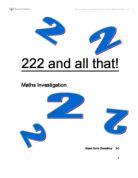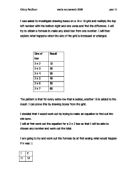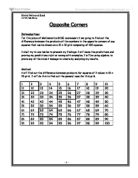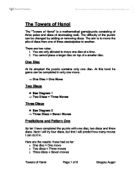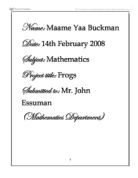222 and all that!
222 and all that! Maths Investigation Sayan Dutta Chowdhury 9C Contents The Project...............................Page 3 3 Digit Numbers.........................Page 4 4 Digit Numbers.........................Page 6 5 Digit Numbers.........................Page 9 6 Digit Numbers............................Page 13 The Formula............................Page 14 Proving The Formula.................Page 16 Bases....................................Page 23 The Project Everyone in year 9 was given the "222 and all that!" maths project to do. We had to write down all the three digit numbers that could be made by rearranging the digits 1, 2 and 7. The combinations were 127, 172, 217, 271, 712 and 721. Then by adding those digits, the answer came to 2220. Next we had to add the three digits, i.e. 1 + 2 + 3 = 10. In the end we divided 2220 by 10 giving us 222. 3 Digit Numbers . Make all the combinations using the three digits. 2. Add the combinations together. 3. Add the three numbers together. 4. Divide ? the combinations divided by ? the three numbers and the answer will always be 222. Examples 23 132 213 231 312 321 Adding the above numbers gives 1332 and 1 + 2 + 3 = 6, so 1332 ÷ 6 = 222. 567 576 657 675 756 765 Adding the above numbers gives 3996 and 5 + 6 + 7 = 18, so 3996 ÷ 18 = 222. 268 286 628 682 826 862 Adding the above numbers gives
GCSE module 5 AQA Mathematics
I was asked to investigate drawing boxes on a 10 x 10 grid and multiply the top left number with the bottom right and vice versa and find the difference. I will try to obtain a formula to make any sized box from one number. I will then explore what happens when the size of the grid is increased or enlarged. Size of box Result 2 x 2 0 2 x 3 20 2 x 4 30 2 x 5 40 2 x 6 50 2 x 7 60 The pattern is that for every extra row that is added, another 10 is added to the result. I can prove this by drawing boxes from the grid. I decided that I would work out by trying to make an equation to find out the nth term. I will at first work out the equation for a 2 x 2 box so that I will be able to choose any number and work out the total. I am going to try and work out the formula by at first seeing what would happen if n was 1: 2 1 2 So the final outcome would be: x12=12 2x11= 22 22-12= 10 This can be proved with other 2 x 2 boxes. For example: 34 35 44 45 34 x 45= 1530 44 x 35= 1540 5- 1530 = 10 Equation. To find n and prove that any number can be selected and its 2 x 2 box can be calculated I can use this method which I have developed in to a formula so any number can be found. n n+1 n+10 n+11 Therefore: n(n+11) = x (n+10)(n+1)= y y- x = 10 PROVE AND TEST using the number 28 as n. 28(28+11) 28 x 39 = 1092 (28+10)(28+1) 38 x 29 =
OPPOSITE CORNERS
Opposite Corners Introduction: For this piece of Mathematics GCSE coursework I am going to find out the difference between the products of the numbers in the opposite corners of any squares that can be drawn on a 10 x 10 grid composing of 100 squares. I shall try to use tables to present my findings; I will make the predictions and proving my predictions right or wrong with examples. I will be using algebra to prove any of the rules I manage to create by analysing my results. Method: I will find out the difference between products for squares of 2 values in 10 x 10 grid. I will do this to find out the general case for this grid. 2 3 4 5 6 7 8 9 0 1 2 3 4 5 6 7 8 9 20 21 22 23 24 25 26 27 28 29 30 31 32 33 34 35 36 37 38 39 40 41 42 43 44 45 46 47 48 49 50 51 52 53 54 55 56 57 58 59 60 61 62 63 64 65 66 67 68 69 70 71 72 73 74 75 76 77 78 79 80 81 82 83 84 85 86 87 88 89 90 91 92 93 94 95 96 97 98 99 00 Example 1: 2 1 2 (11 x 2) - (1 x 12) = 22 - 12 = 10 Example 2: 25 26 35 36 (35 x 26) - (25 x 36) = 910 - 900 = 10 Example 3: 63 64 73 74 (73 x 64) - (63 - 74) = 4672 - 4662 = 10 So, from the above examples I can see that the difference is 10, now I will find out the general case algebraically. GENERAL CASE: n n + 1 n + 10 n + 11 (n + 10)(n
The Towers of Hanoi
The Towers of Hanoi The "Towers of Hanoi" is a mathematical game/puzzle consisting of three poles and discs of decreasing radii. The difficulty of the puzzle can be changed by adding or removing discs. The aim is to move the pile of discs from one of three stacks/poles to another. There are two rules: . You are only allowed to move one disc at a time. 2. You cannot place a larger disc on top of a smaller disc. One Disc At its simplest the puzzle contains only one disc. At this level he game can be completed in only one move. ==> One Disc = One Move Two Discs * See Diagram 1 ==> Two Discs = Three Moves Three Discs * See Diagram 2 ==> Three Discs = Seven Moves Predictions and Pattern One So far I have completed the puzzle with one disc; two discs and three discs. Next I will try four discs, but first I will predict how many moves I can do it in. Here are the results I have had so far: o One disc = One move o Two discs = Three moves o Three discs = Seven moves The first thing I notice is that for each extra disc you can find the number of moves by doubling the number needed for the previous disc and the adding one. ==> ( 1 x 2 ) + 1 = 3 ==> ( 3 x 2 ) + 1 = 7 So for four discs I predict I will take 15 moves as that would be the next result in the pattern. ==> ( 7 x 2 ) + 1 = 15 Four Discs * See Diagram 3 ==> Four Discs = Fifteen Moves Predictions and


